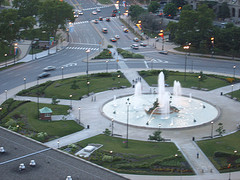
Logan Circle, Philadelphia, Pennsylvania
The Swann Memorial Fountain, also known as The Fountain of the Three Rivers, was created by Wilson Eyre, Jr., and sculptor Alexander Stirling Calder. Eyre designed the basin and the interlacing water jets, including the central geyser that gushed more than 50 feet high. Calder created three bronze Native Americans symbolizing Philadelphia’s principal waterways.
The young girl leaning on her side against an agitated, water-spouting swan represents Wissahickon Creek; the mature woman holding the swan’s neck stands for the Schuylkill River; and the male figure, reaching above his head to grasp his bow as a large pike sprays water over him, symbolizes the Delaware River. The use of swans is an obvious pun on Dr. Swann’s name. Calder’s playfulness is evident in the bronze turtles and frogs that shoot water from the basin.
In 1924, the fountain opened with a celebration which drew ten thousand who people danced and congregated in the streets. In 1979, Pope John Paul II brought 150,000 people together when he celebrated mass from an enormous platform over the fountain.
The fountain forms a midpoint in the long Parkway vista that includes sculptures by two other generations of Calders. At one end of the Parkway is City Hall, for which Stirling Calder’s father, Alexander Milne Calder, designed hundreds of sculptures, including the giant statue of William Penn on the tower. At the Parkway’s opposite end, in the grand stair hall of the Philadelphia Museum of Art, hangs the mobile Ghosts by Alexander Stirling Calder’s famous son, Alexander “Sandy” Calder.
The landscaping accentuates the central position of the Swann Fountain. Ever since Logan Circle opened in the 1920s, its princess trees (Paulownia tomentosa) have been local favorites. Their clusters of purplish flowers appear in early spring, creating a mist of delicate colors. The surrounding beds of flowers and shrubs were originally designed in a formal French pattern, but have since been changed to a looser, more Romantic English style. Masses of tulips, dahlias, grape hyacinths, and azaleas bloom in season.


































